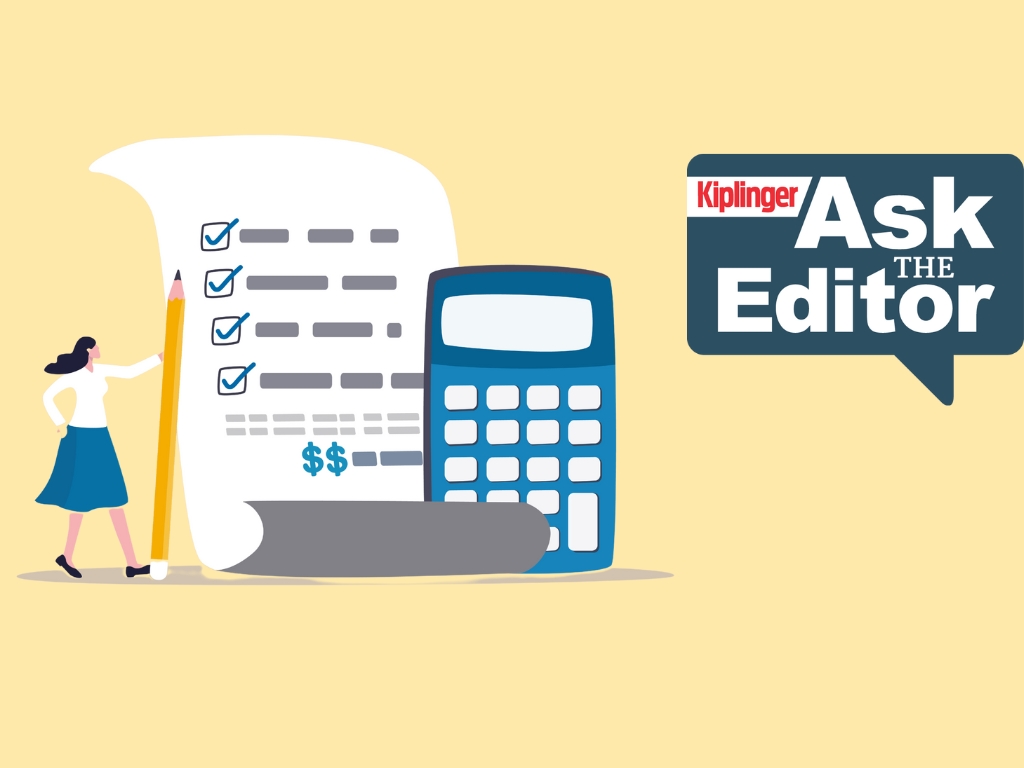As You Approach Retirement, C.A.N. You Handle a Market Downturn?
You know what they say about what goes up. Well, if you’re nervous about what comes next with today’s precipitously climbing stock market, this acronym – C.A.N. – could help calm your fears.


It doesn’t take a lot of grit to handle an uptick in the market. You just watch your portfolio grow and enjoy the ride.
But a market downturn is a different story – especially when you’re nearing or already in retirement. As you watch your savings slip away, anxiety takes hold and the walls of your comfort zone begin to close in on you.
That’s why I think it’s important for retirees and near retirees to understand the emotions that can come into play in a down market and to think through how they want to position their portfolios long before that downturn happens.
From just $107.88 $24.99 for Kiplinger Personal Finance
Become a smarter, better informed investor. Subscribe from just $107.88 $24.99, plus get up to 4 Special Issues

Sign up for Kiplinger’s Free Newsletters
Profit and prosper with the best of expert advice on investing, taxes, retirement, personal finance and more - straight to your e-mail.
Profit and prosper with the best of expert advice - straight to your e-mail.
I refer to this as determining what someone C.A.N. handle, with those letters standing for:
- Capacity
- Attitude
- Need
Let’s break it down and I’ll explain what I mean.
Capacity: How much risk can you withstand, objectively?
Many financial and brokerage firms try to pigeonhole investors, categorizing them as conservative, moderate or aggressive, and then developing their portfolios based on which group they fall under. Fair enough, except those terms can mean different things to different people, and your definition may not align with the financial industry’s definition.
If you’re an aggressive investor, to reach your financial goals you may be comfortable with a market loss as much as 50% at any given year, which is likely what many experienced through the 2008 recession. Moderate investors may be comfortable with a loss of less than 50%, and for conservative investors the percentage could be even less.
So, if someone asks you about your capacity for withstanding loss, it’s important to understand how they categorize conservative, moderate and aggressive investing. And remember, with risk capacity they are talking more about how much risk you need to take to reach certain financial goals, not necessarily what that risk might do to you emotionally.
Attitude: How do you feel about risk? What’s your comfort level?
Set aside for the moment how the financial industry sees risk. What is your personal attitude about it? What percentage loss could you suffer in the next 12 months without shifting into panic mode? Usually, I find that most people give me percentage numbers much lower than what’s generally considered aggressive, moderate and conservative by the financial industry.
Why is that? No one has taken them through the process of assessing their attitude. Instead, everyone focuses on the potential return on investment while ignoring or downplaying the downside risk. But it’s critical to manage downside risk, because this is something that can ruin your retirement.
To explain what I mean, let’s suppose someone is five years out from retirement. They might look back at 2008 and think, “Well, that was tough, but I made it through.” But that was 13 years ago, so there was time to recover before their planned retirement. It’s a different situation entirely when retirement is approaching, because you soon will be making withdrawals from your retirement accounts to pay for your day-to-day living. If the market falls dramatically while at the same time you are making withdrawals, your balance will begin dropping precipitously and recovery will be unlikely. But if you understand your personal attitude about weathering loss, you can build an investment portfolio that will reduce the volatility and should be able to produce results that help you avoid drifting into that panic mode when times turn tough.
At my firm, to help determine someone’s attitude about risk, we use a software program called Riskalyze. It’s based on behavioral psychology and how people make choices between random outcomes versus certain outcomes. I’ve found it to be accurate in helping people figure out who they are.
Need: How much risk do you really need to take?
As you develop an income plan for retirement, it’s important to determine what rate of return you need to have a successful, confident and happy retirement. The answer may not be as much as you initially think. For many people, a 3% to 5% return that supplements their Social Security, pension or other sources of income may be sufficient. In other words, most retirees don’t need to invest aggressively, chasing large returns while placing their retirement at risk.
A question I like to ask retirees is this: If you could double the value of your retirement assets, would that change your lifestyle? Most people answer no, because they have developed a lifestyle in their latter years that they are comfortable with. Then I ask a second question. If you lost half the value of your retirement assets, would that change your lifestyle? The answer to that is an emphatic yes. This is why I spend a lot of time discussing downsides. A big market drop has much more impact for retirees than a huge gain.
What’s the bottom line from all this? It’s simple. You want a financial plan that helps you achieve success while limiting volatility. I liken it to putting guardrails on your retirement portfolio. Just as with the guardrails on a bridge, these investment guardrails keep your journey within certain parameters, but prevent you from falling off.
That gives you more confidence that you are in control of your retirement, rather than allowing the market to be in control of you.
Ronnie Blair contributed to this article.
Investing involves risk, including the potential loss of principal. Heise Advisory Group is an independent financial services firm that utilizes a variety of investment and insurance products. Investment advisory services offered only by duly registered individuals through AE Wealth Management, LLC (AEWM). AEWM and Heise Advisory Group are not affiliated companies. Heise Advisory Group AEWM and Riskalyze are not affiliated companies. Neither Heise Advisory Group nor AEWM can guarantee the accuracy or completeness of the Riskalyze software, calculations or outputs. Riskalyze is intended to be used as a tool in designing a financial portfolio. Investing involves risk, including the potential loss of principal. 1070660-11/21
The appearances in Kiplinger were obtained through a PR program. The columnist received assistance from a public relations firm in preparing this piece for submission to Kiplinger.com. Kiplinger was not compensated in any way.
Profit and prosper with the best of Kiplinger's advice on investing, taxes, retirement, personal finance and much more. Delivered daily. Enter your email in the box and click Sign Me Up.

Ken Heise is co-founder and president of the St. Louis-based Heise Advisory Group (www.heiseadvisorygroup.com). He is an Investment Adviser Representative and a Registered Financial Consultant, a designation awarded by the International Association of Registered Financial Consultants to advisers who meet high standards of education, experience and integrity.
-
 Nasdaq Leads as Tech Stages Late-Week Comeback: Stock Market Today
Nasdaq Leads as Tech Stages Late-Week Comeback: Stock Market TodayOracle stock boosted the tech sector on Friday after the company became co-owner of TikTok's U.S. operations.
-
 Disney’s Risky Acceptance of AI Videos
Disney’s Risky Acceptance of AI VideosThe Kiplinger Letter Disney will let fans run wild with AI-generated videos of its top characters. The move highlights the uneasy partnership between AI companies and Hollywood.
-
 Ask the Editor: Itemized Deductions
Ask the Editor: Itemized DeductionsAsk the Editor In this week's Ask the Editor Q&A, Joy Taylor answers questions on itemized deductions claimed on Schedule A of Form 1040
-
 Are You Putting Yourself Last? The Cost Could Be Your Retirement Security
Are You Putting Yourself Last? The Cost Could Be Your Retirement SecurityIf you're part of the sandwich generation, it's critical that you don't let the needs of your aging parents come at the expense of your future.
-
 I'm an Insurance Pro: It's Time to Prepare for Natural Disasters Like They Could Happen to You
I'm an Insurance Pro: It's Time to Prepare for Natural Disasters Like They Could Happen to YouYou can no longer have the mindset that "that won't happen here." Because it absolutely could. As we head into 2026, consider making a disaster plan.
-
 The Future of Philanthropy Is Female: How Women Will Lead a New Era in Charitable Giving
The Future of Philanthropy Is Female: How Women Will Lead a New Era in Charitable GivingWomen will soon be in charge of trillions in charitable capital, through divorce, inheritance and their own investments. Here's how to use your share for good.
-
 5 Smart Things to Do With Your Year-End Bonus, From a Financial Professional
5 Smart Things to Do With Your Year-End Bonus, From a Financial ProfessionalAfter you indulge your urge to splurge on a treat, consider doing adult things with the extra cash, like paying down debt, but also setting up a "fun fund."
-
 Are You a Gen X Investor? Here's How You Can Protect Your Portfolio From an AI Bubble
Are You a Gen X Investor? Here's How You Can Protect Your Portfolio From an AI BubbleAmid talk of an AI bubble, what's the best course of action for investors in their 50s and 60s, whose retirement savings are at risk from major market declines?
-
 Hey, Retirees: Put Your Charitable Gifts in a Donor-Advised Fund (and Enjoy Your Tax Break)
Hey, Retirees: Put Your Charitable Gifts in a Donor-Advised Fund (and Enjoy Your Tax Break)A donor-advised fund is a simple (really!), tax-smart strategy that lets you contribute a large, tax-deductible gift now and then distribute grants over time.
-
 If You're a U.S. Retiree Living in Portugal, Your Tax Plan Needs a Post-NHR Strategy ASAP
If You're a U.S. Retiree Living in Portugal, Your Tax Plan Needs a Post-NHR Strategy ASAPWhen your 10-year Non-Habitual Resident tax break ends, you could see your tax rate soar. Take steps to plan for this change well before the NHR window closes.
-
 Could Target-Date Funds With Built-In Income Guarantees Be the Next Evolution in Retirement Planning?
Could Target-Date Funds With Built-In Income Guarantees Be the Next Evolution in Retirement Planning?With target-date funds falling short on income certainty, retirement plans should integrate guaranteed income solutions. Here is what participants can do.